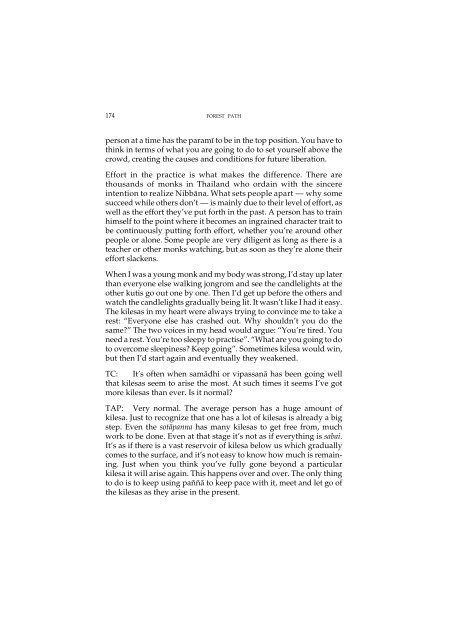Forest Path - Amaravati Buddhist Monastery
Forest Path - Amaravati Buddhist Monastery
Forest Path - Amaravati Buddhist Monastery
Create successful ePaper yourself
Turn your PDF publications into a flip-book with our unique Google optimized e-Paper software.
174 forest path<br />
person at a time has the paramã to be in the top position. You have to<br />
think in terms of what you are going to do to set yourself above the<br />
crowd, creating the causes and conditions for future liberation.<br />
Effort in the practice is what makes the difference. There are<br />
thousands of monks in Thailand who ordain with the sincere<br />
intention to realize Nibbàna. What sets people apart — why some<br />
succeed while others don’t — is mainly due to their level of effort, as<br />
well as the effort they’ve put forth in the past. A person has to train<br />
himself to the point where it becomes an ingrained character trait to<br />
be continuously putting forth effort, whether you’re around other<br />
people or alone. Some people are very diligent as long as there is a<br />
teacher or other monks watching, but as soon as they’re alone their<br />
effort slackens.<br />
When I was a young monk and my body was strong, I’d stay up later<br />
than everyone else walking jongrom and see the candlelights at the<br />
other kutis go out one by one. Then I’d get up before the others and<br />
watch the candlelights gradually being lit. It wasn’t like I had it easy.<br />
The kilesas in my heart were always trying to convince me to take a<br />
rest: “Everyone else has crashed out. Why shouldn’t you do the<br />
same?” The two voices in my head would argue: “You’re tired. You<br />
need a rest. You’re too sleepy to practise”. “What are you going to do<br />
to overcome sleepiness? Keep going”. Sometimes kilesa would win,<br />
but then I’d start again and eventually they weakened.<br />
TC: It’s often when samàdhi or vipassanà has been going well<br />
that kilesas seem to arise the most. At such times it seems I’ve got<br />
more kilesas than ever. Is it normal?<br />
TAP: Very normal. The average person has a huge amount of<br />
kilesa. Just to recognize that one has a lot of kilesas is already a big<br />
step. Even the sotàpanna has many kilesas to get free from, much<br />
work to be done. Even at that stage it’s not as if everything is sabai.<br />
It’s as if there is a vast reservoir of kilesa below us which gradually<br />
comes to the surface, and it’s not easy to know how much is remaining.<br />
Just when you think you’ve fully gone beyond a particular<br />
kilesa it will arise again. This happens over and over. The only thing<br />
to do is to keep using pa¤¤à to keep pace with it, meet and let go of<br />
the kilesas as they arise in the present.

















